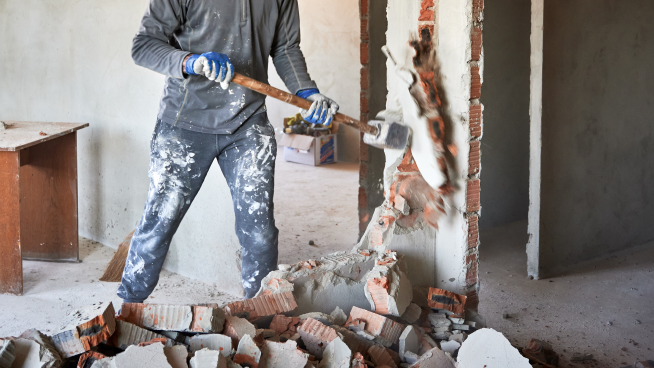Notwithstanding all the attendant safety, staging and personnel issues, Lucas shared with the Guys the brick-by-brick disassembly as the crew quickly realized vital portions of the building’s structural frame were supported by the masonry and had to be both temporarily and then permanently shored up to avoid potential collapse, much less the possibility of sagging floors and roofline.
The Guys have seen many similar situations during the years where threats posed by cave-in with an open excavation, rotted wood roof decks that a laborer may step through, toxic dust created by wall collapse, and many other such conditions that remind us of the need for professionals in this arena.
There are many advantages to expert deconstruction vs. the sledgehammer approach.
Included in the concern for the building structure, careful disassembly may preserve materials for future use or even reapplication on the same job. This is frequently the case with masonry, custom roofing materials, windows and exterior siding.
Recycling is a huge business for certain types of detritus, including copper and aluminum and some plumbing fixtures, wood trim and lights.
Legal disposition of materials is another consideration. Some people will simply dump all types of material into a convenient landfill or even on vacant land belonging to others.
A professional company understands that certain materials, such as asbestos, must be disposed of in an approved manner.
Airborne asbestos and lead dust can potentially contaminate grounds and other buildings. PCBs and a myriad of potentially harmful solvents may be a part of or stored in a demo property.
And above all of these is worker safety. Project demolition is laced with concerns that could negatively affect personnel, from safe handling of the materials mentioned above to fall protection, danger from falling debris, unexpected collapse, airborne dust, electric shock, rupture of old gas lines and many others.
LaFave shared with us a recent project that involved removal of an old fuel oil tank. LBS spent a lot of time first pumping the tank for proper disposal of the residual solvent, applying material inside the tank to remove any remaining matter, then carefully hand digging to ensure the old metal was not breached prior to removal.
This compares to some that might simply cover it up and hope for the best, ignoring the fact that a tank spill could contaminate not only the soil on the building lot, but adjoining lots and the aquifer below.
Some projects involve permits prior to tear down and some also require a letter of clearance from all affected utilities to ensure items have been properly disconnected.
Use of heavy equipment such as hydraulic jack hammers attached to large machines involves huge cost, potential liability, staging issues getting the equipment to the site, and risk of damaging such things as ditches, swales, underground sprinklers, drains and others.
Another benefit of professional companies is the insurance coverage they carry to afford protection for all of the items we’ve discussed.
Years ago, a spill in the garage of an older home contaminated the surrounding earth including abutting properties and resulted in damage claims that reached six figures to provide clean up and restoration of the land, and the emotional rehabilitation of the affected claimants.
Whether you are removing an old storage shed in the backyard or clearing a large site for future redevelopment, a professional demolition company should be your first call.
And, as always, you can find them at InsideOutsideGuys.com.
For housing advice and more, listen to “The Inside Outside Guys” every Saturday and Sunday on 760 WJR from 10 a.m. to noon, or contact them at InsideOutsideGuys.com.








